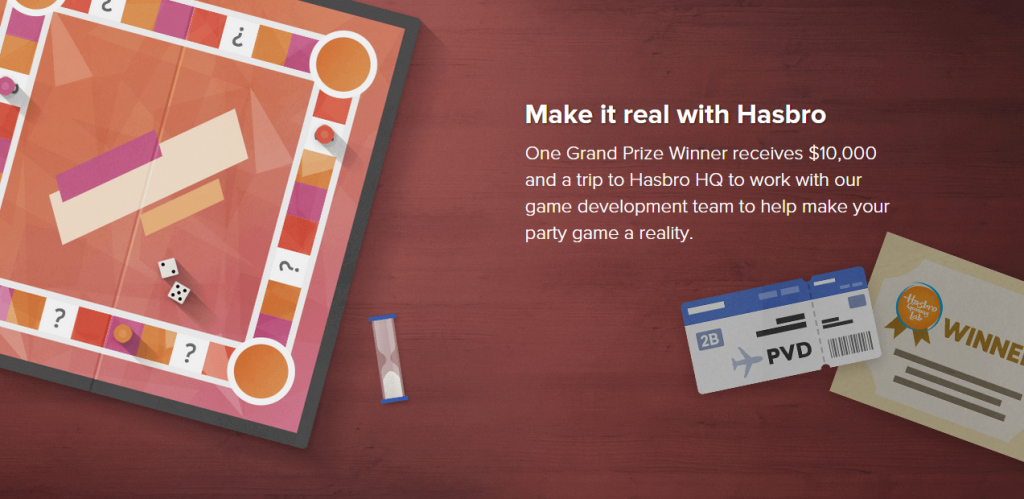So here’s something I’ve learned recently: prototyping a card game is a pain in the ass. Oh, I don’t mean it’s unenjoyable; it’s actually a crazy amount of fun, to watch a game take shape before your eyes. But it’s also a lot of tedious, time-consuming, fiddly work, especially if your workflow consists of “the first thing that came to mind” — and when your goal is to mercilessly hack a game together from scratch, taking hours to implement every minor tweak can become a huge psychological deterrent.
What brings all this on?
Well, Hasbro recently decided to run a Willy Wonka -like game design contest. Here’s the gist: the crowdfunded tabletop renaissance is eating away at Hasbro’s margins. In the interest of staying hip, they’ve partnered with Indiegogo to host a contest aimed at finding “the next great party game” aka “we want that phat Cards Against Humanity money”. The finalists get help pushing their campaigns from Hasbro’s PR department, and the winner gets a $10,000 prize and a licensing offer.

I decided I was going to design and enter a game, and over the past month, blitzed through a dozen different ideas before finding The One: a head-to-head debate game called Fight About It. And while the game now works and is a blast to play, it didn’t reach that point easily — it took a lot of iterative design and way more wasted notecards than I care to admit.
This is something game designers call “prototyping”: the process of designing a game, playing it, destroying it, and designing it again, tweaking rules and fiddling with numbers as you gradually carve out the true shape of the thing.
But to my surprise, there are actually a shockingly small number of resources available to the amateur board-game designer. For card games? Even less.
There’s a pretty exhaustive list over on Boardgame Geek, but frankly, the results are all over the place. Some programs have almost no flexibility. Others, like nanDECK, have that “programmed by an engineer” quality, where the learning curve looks like a brick wall and you have to be psychic to do anything.
So where is a budding designer to turn?
Card Maker: Your New Best Friend
Having now demoed dozens of different methods, I’m happy to report that I’ve found The Final Solution: that magic missing-link piece of software specifically designed for rapidly iterating a card-game as quickly as possible. If you follow these directions, it will take you about two hours to learn the software, after which you’ll have the ability to take a card game from concept to deck in less than half an hour.
The answer, my friends, is Card Maker.
An open source project, Card Maker was created in 2009 by Tim Stair, a hobbyist designer just as frustrated as I was by the lack of simple software solutions for card-game prototyping.
So he made his own — and unlike most open-source software, included extensive help documentation! The result, while by no means pretty, blows all alternatives out of the water.

Here’s how it works:
- You create your cards as spreadsheets, saved in .csv format. The first row contains their category-headings, and subsequent rows contain data. If you want to include a certain amount of any specific card, all you have to do is make sure the left-most column contains that number.
- In Card Maker, you create layouts for various card-types, which tell the software what data you’d like to show up and where.
- Then you add your .csv files as a “reference” for those layouts to draw from.
And that’s it. You’re done. Print it out, cut it up, and take it to the table. The beauty of this program is that it makes tweaking cards a breeze: you just change a few digits in a spreadsheet and upload the reference in Card Maker again.

The program also gives you infinite fiddly control over your cards’ dimensions, gutters, and layout on a print-sheet. So if your cards are small, square, and you want to print 400 to a page? You can do that. If your cards are poker-sized and you want 9 per page? You can do that, too. You can also compile print-sheets by card, by template, or pulling from the whole deck.

Using Card Maker, I can print out a version of my game, playtest it, scrap it, tweak every card in the deck, print it out, and playtest again, all in the space of an hour. That’s nothing short of monumental. That’s like having a goddamn super-power.
Now, it’s important to state that this is NOT typesetting software. You would not use this to create a finished deck; you’d use something like InDesign or Illustrator (or you’d pay someone to do that for you). Card Maker is a purpose-built weapon designed for optimal playtesting and nothing else.
That said, when you’ve finally got things working and are ready for a more durable playtest model, you can step up from printer-paper to card-stock, and the results aren’t half-bad.

And there you have it: the amazing million-dollar time-saver I wish someone would have told me. Hopefully this will prove useful to at least one person out there.
Happy playtesting!
———-
EDIT:
Oh, and as a side-note: if you download Card Maker and like it as much as I do, be sure to drop its creator, Tim Stair, a Paypal donation at nhmk@nhmk.com.
